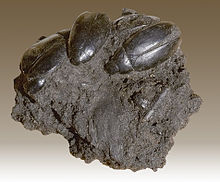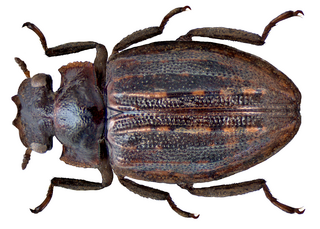
Spercheus is a genus of aquatic beetles which are placed in a family of their own, Spercheidae within the Hydrophiloidea. About 20 species are known from around the world except the Nearctic with the majority being from the Oriental and Afrotropical Realms.

Hydrophilidae, also known colloquially as water scavenger beetles, is a family of beetles. Aquatic hydrophilids are notable for their long maxillary palps, which are longer than their antennae. Several of the former subfamilies of Hydrophilidae have recently been removed and elevated to family rank; Epimetopidae, Georissidae, Helophoridae, Hydrochidae, and Spercheidae. While the majority of hydrophilids are aquatic, around a third of described species are terrestrial, mostly belonging to the subfamily Sphaeridiinae.

Hydrophiloidea, known as water scavenger beetles, is a superfamily of beetles. Until recently it included only a single family, the Hydrophilidae, but several of the subfamilies have been removed and raised to family rank. Hydrophiliidae remains by far the largest member of the group, with nearly 3,000 described species. The other families have no more than 400 species. The Histeroidea are closely related and sometimes considered part of a sensu lato Hydrophiloidea. The majority of the clade is aquatic, which is thought to be the ancestral ecology of the group, with some lineages like Sphaeridiinae becoming secondarily terrestrial. Modern representatives of the group first appeared during the Late Jurassic.

Berosus is a genus of beetles in the family Hydrophilidae, the water scavenger beetles. The genus contains 273 species. It is distributed worldwide.

Hydrophilus palpalis is a species of water scavenger beetles belonging to the Hydrophilinae subfamily.
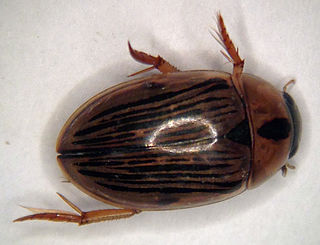
Tropisternus is a genus of hydrophilid beetles with 63 species in five subgenera in North and South America.

Helochares is a genus of water scavenger beetles in the family Hydrophilidae, represented by 161 described species. It is distributed across the Afrotropical, Australasian, Indo-Malayan, Nearctic, and Palearctic realms.
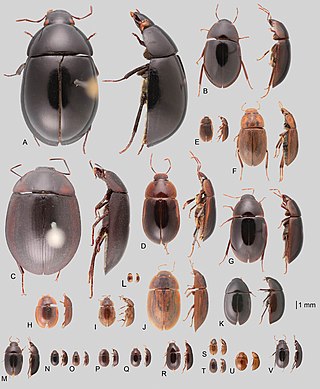
Acidocerinae is a subfamily in the family Hydrophilidae of aquatic beetles, and it contains over 500 species in 23 genera.

Sphaeridium is a genus of beetles in the family Hydrophilidae, the water scavenger beetles. They occur in Europe, and some species have been introduced to North America.

Laccobius is a genus of water scavenger beetles in the family Hydrophilidae. There are more than 80 described species in Laccobius.

Hydrobiomorpha is a genus of water scavenger beetles in the family Hydrophilidae. There are 56 extant described species in Hydrobiomorpha, along with several fossil species.

Hydrophilus triangularis, known generally as the giant black water beetle or giant water scavenger, is a species of water scavenger beetle in the family Hydrophilidae. It is the most common and widespread species of Hydrophilus in North America, being found across the contiguous United States, southern Canada, and Mexico.
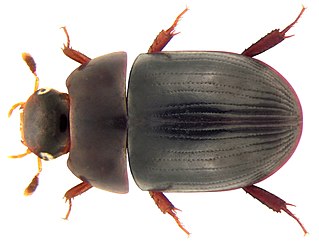
Dactylosternum is a genus of water scavenger beetles in the family Hydrophilidae. There are more than 20 described species in Dactylosternum.

Hydrophilus ovatus is a species of water scavenger beetle in the family Hydrophilidae. It is found in the eastern United States from Maine south to Florida and west to Texas and Kansas, southern Ontario and Quebec, and south to southern Mexico.
Hydrophilus ensifer is a species of water scavenger beetle in the family Hydrophilidae found in the Americas. As of 2020, there are two valid subspecies of H. ensifer, H. e. ensifer and H. e. duvali, however the differences among the subspecies are not well understood.

Coelostoma is a genus of beetles belonging to the family Hydrophilidae. The genus was first described by Brullé in 1835. The genus has cosmopolitan distribution, with 111 described species, representing one of the most diverse genera of Hydrophilidae.
Brownephilus is a genus of water scavenger beetles in the family Hydrophilidae containing two described species. Brownephilus was formerly a subgenus of Hydrobiomorpha and was elevated to genus by Andrew E.Z. Short in 2010.
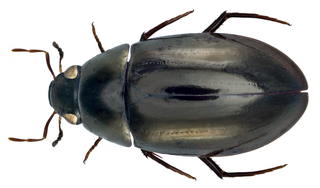
Sternolophus is a genus of water scavenger beetles in the family Hydrophilidae containing nine described species in two subgenera.

Coelostoma (Coelostoma) vitalisi, is a species of water scavenger beetle found in China, Taiwan, Japan, India, Indonesia, Japan, Malaysia, Nepal, Singapore, Sri Lanka, Cambodia, Thailand and Vietnam.

Allocotocerus is a genus of water beetles in the family Hydrophilidae, first described by Ernst Gustav Kraatz in 1883. The decision for synonymy is based on Hansen (1999).

